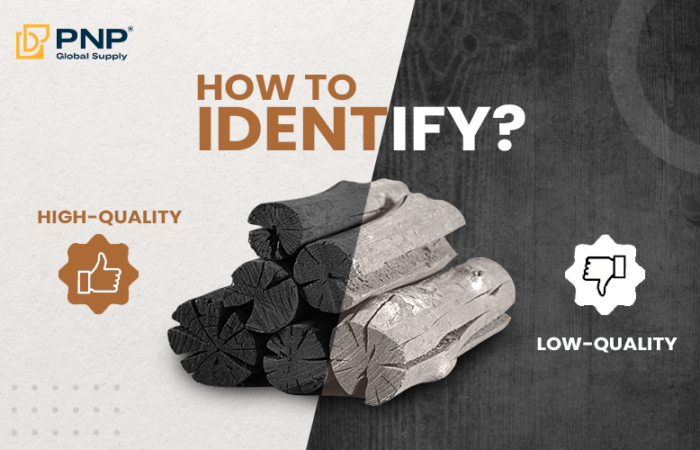When choosing the right smoker for your BBQ, understanding the fundamental differences between charcoal and pellet smokers is crucial. Both offer unique advantages that cater to distinct cooking styles and flavor preferences. This guide provides an in-depth look into each system, their operational principles, pros and cons, and key factors to consider, empowering you to make an informed decision for your next grilling adventure.
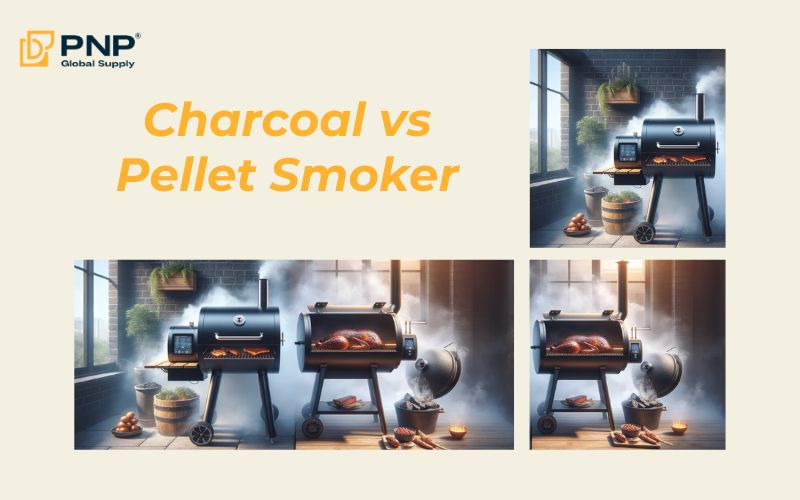
What Is a Charcoal Smoker?
Definition and How It Works
A charcoal smoker is a traditional cooking device that utilizes burning charcoal to generate both heat and smoke, perfect for slow-cooking meats, fish, or vegetables. It typically consists of:
- Firebox and Cooking Chamber: The smoker is divided into a firebox (where the charcoal burns) and a cooking chamber (where the food is placed).
- Vents and Dampers: These components allow you to control the airflow, thereby regulating the temperature and the intensity of the smoke.
- Fuel Source: It uses either lump charcoal or briquettes. The process begins by lighting the charcoal, which produces glowing embers and smoke. By adding wood chunks (such as hickory or mesquite), you further enhance the smoky flavor.
Charcoal smokers are available in various styles, including bullet-style (e.g., Weber Smokey Mountain), offset smokers, and kamado grills. With a history spanning centuries, they embody the classic BBQ experience cherished by enthusiasts around the globe.
Pros and Cons of Charcoal Smokers
Pros:
- Rich, Authentic Flavor: The combination of charcoal combustion and wood chunks produces a deep, smoky taste that is hard to replicate. The fat drippings hitting the coals add an extra layer of flavor and help form that desirable smoke ring.
- High Heat Capability: These smokers can reach temperatures up to 700°F or more, making them ideal for searing and versatile cooking.
- Affordable Entry: Basic charcoal smokers are relatively low-cost, with prices typically starting between $100 and $300, and charcoal itself is an economical fuel option (around $5-$15 per bag).
- Hands-On Control: For those who enjoy a tactile cooking experience, managing the vents and fuel adds an element of artistry and engagement.
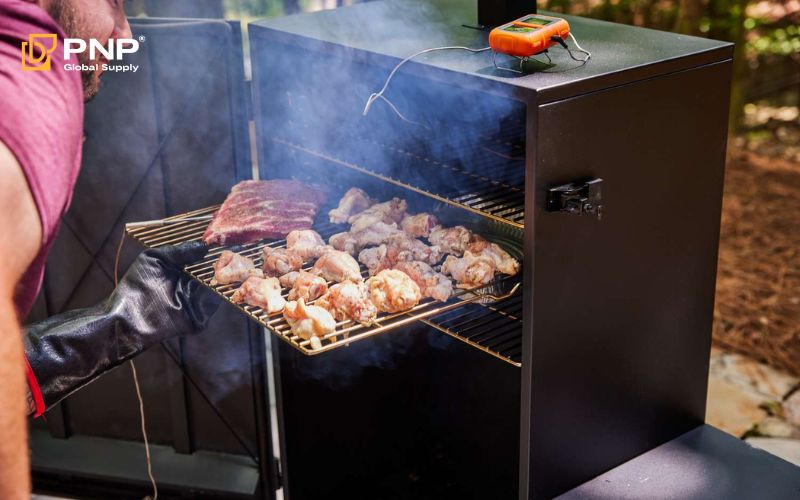
Cons:
- Steep Learning Curve: Mastering the art of temperature and smoke control through vent adjustments and fuel management requires practice and skill.
- Time-Intensive: Lighting the smoker and achieving a stable cooking temperature can take 20-40 minutes, and active monitoring is often necessary throughout the cooking process.
- Messy Cleanup: The production of ash and soot means that regular cleaning—such as scraping grates and disposing of ash—is required.
- Weather Sensitivity: External factors like wind or cold weather can disrupt the heat consistency if the smoker is not properly shielded.
Real-World Applications
Charcoal smokers are favored by traditionalists who appreciate the authenticity and craftsmanship involved in BBQ. They are perfect for creating a robust, smoky flavor profile in dishes like slow-smoked ribs, brisket, and pulled pork. If you enjoy being hands-on and adjusting every detail of your cooking process, the charcoal smoker offers a rewarding experience that deepens your connection with the art of BBQ.
What Is a Pellet Smoker?
Definition and How It Works
A pellet smoker is a modern appliance that combines the convenience of automation with the authentic taste of wood-fired cooking. Often referred to as a pellet grill (with popular brands like Traeger or Pit Boss), it operates as follows:
- Pellet Hopper and Feed System: The hopper stores compressed hardwood pellets made from oak, apple, pecan, or other hardwoods.
- Electric Igniter and Combustion: An electric igniter initiates the combustion of pellets in the fire pot.
- Fan-Driven Airflow: A built-in fan circulates heat and smoke throughout the cooking chamber, ensuring even cooking.
- Digital Controller: This allows precise temperature regulation (ranging from 180°F for smoking to 500°F+ for grilling) with an accuracy of ±10°F, providing consistent results with minimal intervention.
Pellet smokers emerged in the 1980s and have since become popular among tech-savvy BBQ enthusiasts who value consistency and ease of use.
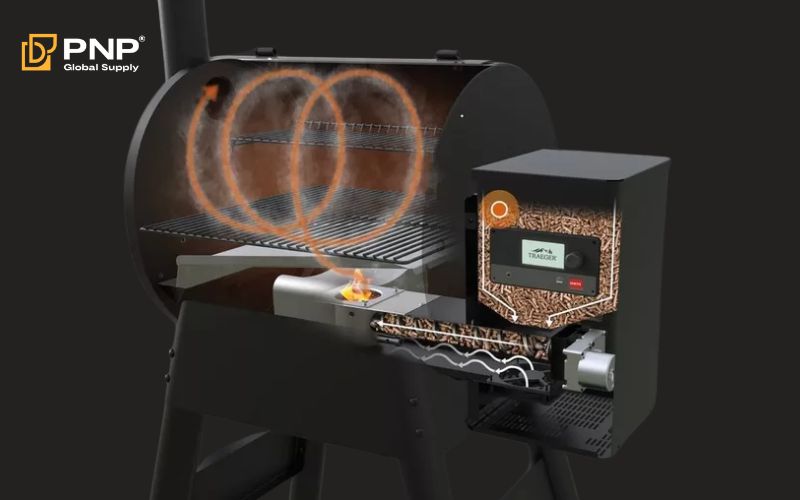
Pros and Cons of Pellet Smokers
Pros:
- Ease of Use: The “set-and-forget” digital controls make pellet smokers very user-friendly, even for beginners. Simply dial in your desired temperature, and the unit takes care of the rest.
- Consistent Results: Automated heat regulation ensures even cooking over long periods, reducing the need for constant monitoring.
- Flavor Options: With a variety of wood pellet flavors available (e.g., cherry, hickory), you can easily customize the taste of your food.
- Low Maintenance: The contained burn produces minimal ash, making cleanup straightforward.
Cons:
- Higher Cost: Pellet smokers typically range from $300 to $1,500, and the ongoing cost of pellets (about $15-$30 per 20-pound bag) is higher compared to charcoal.
- Milder Smoke: The controlled burn process results in a subtler smoke flavor, which might not satisfy those who prefer a more intense, traditional BBQ taste.
- Power Dependency: These smokers require an electrical outlet, limiting their use in off-grid or remote settings.
- Complex Repairs: The presence of mechanical components like augers and fans means that, if something goes wrong, repairs can be more complicated and potentially costly.
Real-World Applications
Pellet smokers are ideal for home cooks who value convenience and consistency. They are particularly well-suited for long, unattended smoking sessions where precise temperature control is essential. Whether you’re smoking ribs, grilling chicken, or even baking pizza, the pellet smoker provides a reliable, automated solution that simplifies the cooking process while still delivering a pleasing wood-fired flavor.
Key Differences Between Charcoal and Pellet Smokers
When it comes to choosing the right smoker for your BBQ, it’s essential to understand the key differences between charcoal and pellet smokers. This guide covers their operational principles, pros and cons, and critical aspects such as flavor, temperature control, cooking time, convenience, cost, and maintenance.
Below is a detailed comparison table:
| Comparison Factor | Charcoal Smoker | Pellet Smoker | Overall Assessment |
| Flavor | – Delivers a robust, traditional smoky flavor with a distinctive smoke ring from burning charcoal and added wood chunks. – Fat drippings enhance the natural, rich taste. | – Offers a milder, more refined wood-infused flavor due to controlled pellet combustion. – Flavor can be customized by using various pellet types (e.g., cherry, hickory). | Charcoal: Ideal for traditional BBQ lovers. Pellet: Suits those who prefer a subtler, versatile flavor profile. |
| Temperature Control | – Relies on manual adjustments using vents, dampers, and careful fuel placement. – Requires skill and experience to maintain a consistent temperature. | – Features automated digital controls with an accuracy of ±10°F, ensuring steady, consistent temperatures. – Minimal user intervention required for long, unattended smoking sessions. | Pellet: Excels in consistency. Charcoal: Appeals to those who enjoy hands-on control. |
| Cooking Time & Convenience | – Typically takes 20-40 minutes to light and stabilize, with periodic refueling required every 1-2 hours. – Offers an interactive, artisanal cooking experience. | – Heats up quickly in 10-15 minutes and can operate autonomously for 6 to 20 hours depending on hopper capacity. – “Set-it-and-forget-it” functionality saves time and effort. | Pellet: Clearly superior for convenience and time-saving. |
| Cost & Maintenance | – Lower upfront cost (approximately $100-$500) with inexpensive fuel ($0.50-$1 per pound). – Requires regular cleaning (ash removal, scrubbing grates) and rust prevention. | – Higher initial investment (around $300-$1,500) with costlier pellets ($15-$30 per 20-pound bag). – Lower maintenance demands due to contained ash systems and drip trays, though electronic repairs may be needed. | Charcoal: More budget-friendly initially. Pellet: Benefits from reduced maintenance efforts over time. |
Which One Should You Choose?
The decision between a charcoal smoker and a pellet smoker ultimately depends on your BBQ priorities and lifestyle.
If You Prefer Traditional BBQ Flavor:
Choose a Charcoal Smoker if you:
- Crave that intense, authentic smoky taste only achievable through charcoal combustion.
- Enjoy the hands-on process of managing fire, adjusting vents, and adding fuel.
- Are budget-conscious and appreciate the lower cost of both the smoker and the fuel.
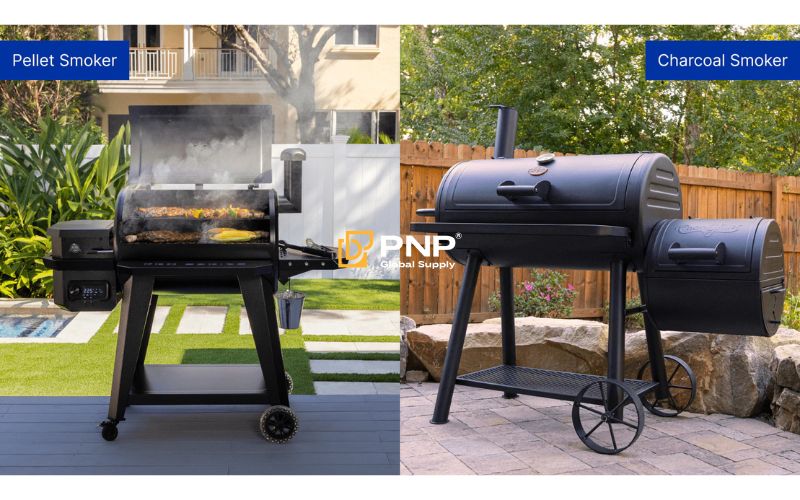
If You Want a Hassle-Free, Consistent Experience:
Choose a Pellet Smoker if you:
- Value ease of use and prefer a set-it-and-forget-it approach with automated controls.
- Desire consistent, even cooking with minimal intervention.
- Appreciate versatility in cooking options-from smoking to grilling to baking-all in one unit.
- Are drawn to modern technology and digital precision in your cooking process.
Other Factors to Consider Before Buying
Beyond the basic comparisons, several additional factors might influence your choice between a charcoal and a pellet smoker:
Environmental Impact
- Charcoal Smoker: Using lump charcoal from sustainable sources (e.g., bamboo) can be eco-friendly. However, some briquettes contain additives that may emit more CO₂.
- Pellet Smoker: Often utilizes pellets made from sawdust byproducts, which reduces waste. While the use of electricity does add a carbon footprint, the cleaner combustion process can offset some emissions.
Takeaway: Pellet smokers have a slight edge environmentally, though sustainably sourced charcoal (like those from reputable suppliers such as PNP Charcoal) can close the gap.
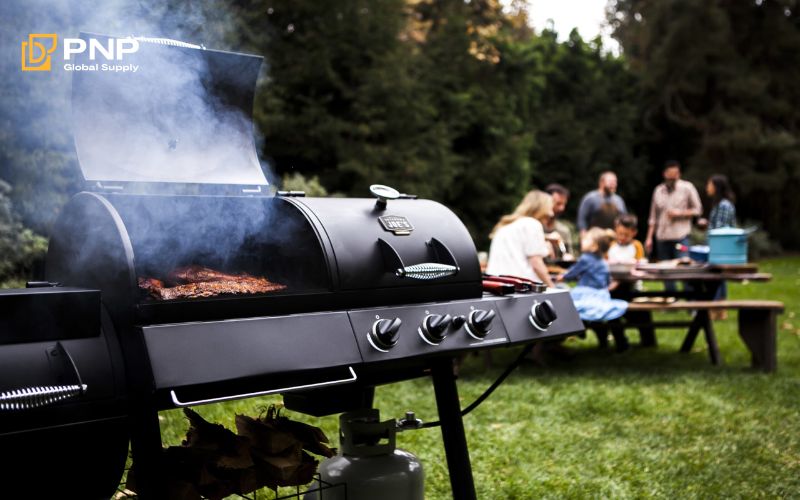
Portability and Outdoor Use
- Charcoal Smoker: Offers excellent portability with no need for an electrical outlet, making it ideal for camping or remote cookouts. However, larger offset models can be bulky.
- Pellet Smoker: Generally heavier and requires electricity, which may limit off-grid usage despite some models being designed for relative mobility.
Takeaway: Charcoal smokers are typically more flexible for outdoor, off-grid applications.
Maintenance and Cleaning
- Charcoal Smoker: Requires frequent cleaning due to ash and grease buildup; regular scrubbing and maintenance are necessary to ensure longevity.
- Pellet Smoker: Benefits from contained ash systems and drip trays, making the cleaning process simpler and less time-consuming.
Takeaway: Pellet smokers are lower maintenance, saving you time and effort post-cookout.
Discover Premium Charcoal and Charcoal Briquettes Pellets at PNP Charcoal
No matter which smoking method you choose, fueling your smoker with high-quality products is essential. PNP Charcoal offers sustainably sourced lump charcoal, briquettes designed to elevate your BBQ experience:
- Sustainability: Eco-friendly sourcing minimizes environmental impact.
- Quality: Top-tier fuel enhances both flavor and performance.
- Variety: Options tailored for both traditional and modern smoking methods.
Visit PNP Charcoal to explore premium fuel choices that can take your BBQ to the next level.
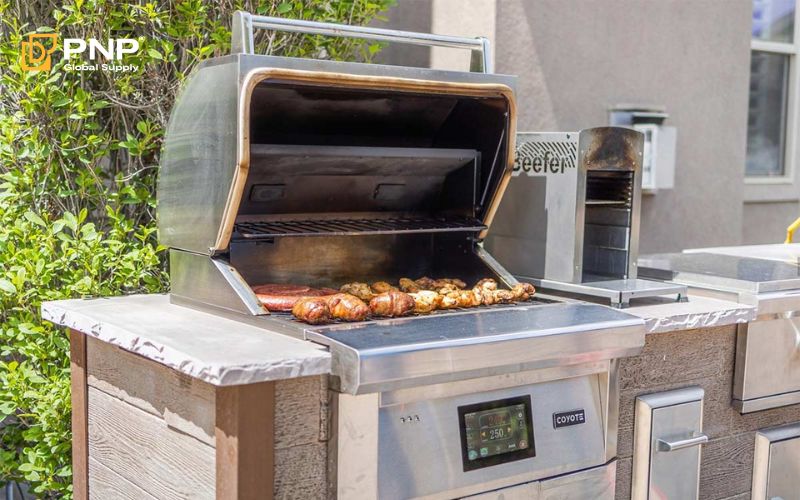
Frequently Asked Questions About Charcoal vs Pellet Smoker
1. Can a Pellet Smoker Match the Flavor of a Charcoal Smoker?
While pellet smokers deliver a solid wood-infused flavor, it tends to be milder compared to the robust smokiness produced by charcoal smokers. Adding wood chunks to a pellet smoker can enhance the flavor, but it may not fully replicate the depth of traditional charcoal smoking.
2. Which Smoker is Better for Long Smoking Sessions?
Pellet smokers excel during long, unattended smoking sessions (8-20 hours) thanks to their large hopper capacity and automated controls. Although charcoal smokers can also manage long cooks, they require regular refueling and monitoring every 1-2 hours.
3. Are Charcoal Smokers Cheaper to Run Than Pellet Smokers?
Yes, charcoal smokers generally have lower operating costs with fuel priced around $0.50-$1 per pound, and the units themselves tend to be more affordable. Pellet smokers, with their higher initial and fuel costs, may incur additional expenses, although their efficiency can help balance the costs over time.
Which Smoker Fits Your BBQ Lifestyle?
Ultimately, your choice between a charcoal smoker and a pellet smoker should reflect your personal cooking style, flavor preferences, and lifestyle:
- For an Authentic, Hands-On BBQ Experience: Opt for a charcoal smoker to enjoy the robust, traditional flavors and the engaging process of managing your fire.
- For a Convenient, Consistent, and Modern Approach: Choose a pellet smoker for its digital precision, ease of use, and versatility in the kitchen.
Both options have distinct strengths that cater to different BBQ enthusiasts. By understanding these differences and considering your priorities, you can confidently invest in the smoker that best aligns with your culinary aspirations.
With a deep understanding of both technologies and over a decade of experience in SEO, sales, and marketing, this guide has been crafted to help you navigate the world of BBQ smokers with expert insight and clarity. Enjoy your journey into the art of smoking, and may every cookout be a delicious success!
If you have further questions or need personalized advice, our team is here to help you master the art of BBQ.

